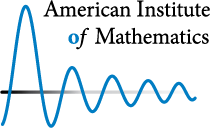1. Ehrhart Positivity
-
Conjecture 1.05.
Let $[n]:=\{1,\ldots,n\}$ be a groundset, and let $i(P; t)$ denote the Ehrhart polynomial of a lattice polytope $P$. Then coefficient-wise, $$i(T_{r,n}; t) \leq i(\mathsf{Pan}_{s,r,n};t) \leq i(U_{r,n};t),$$ where $T_{r,n}$ is the rank $r$ minimal matroid on $[n]$, $U_{r,n}$ is the rank $r$ uniform matroid on $[n]$, and $\mathsf{Pan}_{s,r,n}$ is the rank $r$ Panhandle matroid on $[n]$. -
Problem 1.1.
What is known (or can be shown) about the Ehrhart positivity of polytopes related to Birkhoff polytopes (e.g., transportation polytopes)? -
Problem 1.15.
Are $d$-dimensional smooth polytopes with $\leq d+3$ facets Ehrhart positive or satisfy the higher integrality condition? -
Problem 1.2.
- (a) Is there a closed formula for the Ehrhart polynomial of order polytopes of fence posets? Further, are these Ehrhart polynomials Ehrhart positive?
- (b) Is the $h^\ast$-polynomial of the order polytopes from (a) real-rooted?
- (c) Can this be extended to generalized permutahedra?
-
Problem 1.25.
Does a rational polygon $P\subseteq \R^2$ with quasi-period 1 satisfy Scott’s inequality? That is, assuming $i\geq 1$, is the inequality $b\leq 2i+7$ satisfied, where $b$ and $i$ represent the number of boundary and interior lattice points of $P$, respectively. -
Problem 1.3.
Let $ASM_n$ denote the $n$th alternating sign matrix polytope (defined as the convex hull in $\mathbb{R}^{n^2}$ of the $n\times n$ alternating sign matrices). It is known that $i(ASM_n;t)$ is Ehrhart positive. What further can be said about $i(ASM_n;t)$? Furthermore, what can be said about $h^*(ASM_n;z)$? -
Definition: Given two lattice polytopes $P\subseteq \R^d$ and $P'\subseteq\R^{d'}$, the join of $P$ and $P'$ is given by $$P*P' := \mathrm{conv}\{(P,0_{d'},1) \cup (0_{d},P',0)\}.$$
Problem 1.35.
For lattice polytopes $P$ and $P'$, which Ehrhart-theoretic properties pass through their join? For example, if $P$ and $P'$ are both Ehrhart positive, is $P*P'$ as well? -
Problem 1.4.
In types B, C, and D, the stretched Clebsch-Gordon coefficients are period-2 quasi-polynomials. Are the coefficients of the constituent polynomials always positive? -
Problem 1.45.
Consider rational polygons of denominator 2. The Ehrhart quasi-polynomial has two constituent polynomials, one of which is an Ehrhart polynomial. Classify the other constituent polynomial.
Note that this is settled for up to 2 interior lattice points. -
Problem 1.6.
- (a) Consider the Ehrhart polynomial of a lattice polytope $P$. Below are two well-known representations of $i(P;t)$:
$$i(P;t) = \sum_{i=1}^d c_it^i = \sum_{i=0}^d h_i^* \binom{t+d-i}{d}.$$
Fix $k\in \Z_{>0}$ and write $i(P;t)$ in the basis $\{(t-k)^i\}_i$. (For example, if $\deg(h^*(P;z)) = s$, then $i(P;t)$ is nonnegative in the basis $\{(t-s+1)^i\}_{i=0}^{d}$.)
Investigate what happens when changing $k$ from 0 to 1 for non-Ehrhart positive polytopes (or other $k$). - (b) If $P$ is Ehrhart positive in the standard basis, is it Ehrhart positive in the basis $\{t^i(t+1)^{d-i}\}$?
- (a) Consider the Ehrhart polynomial of a lattice polytope $P$. Below are two well-known representations of $i(P;t)$:
$$i(P;t) = \sum_{i=1}^d c_it^i = \sum_{i=0}^d h_i^* \binom{t+d-i}{d}.$$
Fix $k\in \Z_{>0}$ and write $i(P;t)$ in the basis $\{(t-k)^i\}_i$. (For example, if $\deg(h^*(P;z)) = s$, then $i(P;t)$ is nonnegative in the basis $\{(t-s+1)^i\}_{i=0}^{d}$.)
Cite this as: AimPL: Ehrhart polynomials: inequalities and extremal constructions, available at http://aimpl.org/ehrhartineq.
